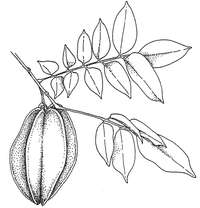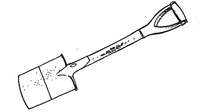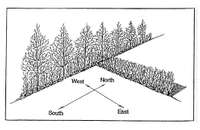- Limit Fertilizer After Transplanting Trees and Shrubs
- Watering Cups Used in Planting Trees
- Successful Method of Taking Fruit Trees from the States to Zaire
- Mud Dip for Roots When Transplanting
- Tree Spacing Numbers
- Grow Small Fruit Trees in Circles
- Danger Signal of Heavy Flowering
- "The Living Fence, Its Role on the Small Farm"
- Book Review: Hedges for Resource-Poor Land Users in Developing Countries
- Newsletter Review: The ITTO Tropical Forest Update
LIMIT FERTILIZER AFTER TRANSPLANTING TREES AND SHRUBS. [The following is adapted from the May 1993 issue of The Avant Gardener.] This has long been an accepted but unproven rule. Now a study by Dr. Warren at the North Carolina State University "has shown that root growth decreases as the amount of nitrogen fertilizer is increased. Nitrogen apparently does not enhance regeneration of roots pruned during digging.
"Many studies have demonstrated that after root loss, growth is redistributed in favor of making new roots. Above-ground growth slows as nutrients are transferred to the roots. So it is a mistake to apply fertilizer in an attempt to stimulate top growth, since the plant's 'instinct' is to regenerate a full root system. NCSU experiments showed that replacing damaged roots is slowed at a rate directly correlated to the amount of nitrogen fertilizer used. This may negatively impact transplant survival and prolong the establishment period. Little or no nitrogen should be applied in the first year after transplanting."
ECHO asked Dr. Warren to clarify some points. Does this apply only when the plant has been dug up and root damage has occurred, or also when a plant is carefully transplanted from a pot into the soil? "I have no direct data, but I believe it applies to all transplanted material since establishment is still dependent upon generating new roots into surrounding soil." Do you mean to add no fertilizer or just no nitrogen fertilizer? "The data is only applicable to nitrogen fertilizer. I would make sure there are adequate levels of P and K. Recent information suggests that these two do not interfere with root growth."
WATERING CUPS USED IN PLANTING TREES. Joel Matthews in Niger wrote, "In experimenting with direct seeding and transplanting seedlings, I have found that a trench with 'watering cups' greatly increased survivability of new seedlings in hot, dry sun scorched areas." In an area where Joel wanted to make a living fence, he dug a narrow trench about 8 inches (20 cm) deep. At spots where a tree was to be planted, he loosened the soil perhaps another 8 inches deep and made a slight depression for hand watering if needed. He calls these "watering cups."
"When preparing my living fence, I only did a portion as a trench; the others were in a slight depression. I direct seeded Ziziphus mauritiaca and Z. spina christi in mid May. After a 3 week moist period we had almost a full month without rain. The result--80% of the seedlings in the trench survived with periodic watering, whereas only 40% of the seedlings with watering cup only but no trench survived. My trial with no watering cups and no trench saw only about a 20% survival rate." Benefits cited include: lower soil temperature, greater moisture retention, wind protection, protection from animals, overhead shading possible (e.g. by placing corn stalks over the trench), water catchment, and improved microclimate. [Might birds be less likely to dig up seeds or pull up young seedlings?]
SUCCESSFUL METHOD OF TAKING FRUIT TREES FROM THE STATES TO ZAIRE. See above about Roy Danforth's large collection of tropical fruit trees. He collected many potted trees while in the States one winter. "In all I bare-rooted and bagged 315 trees, threw them into trunks and carried them for 4 1/2 days. I'm pleased to report that not one of them died in transport."
 Here is Roy's procedure. (1) Shake the tree to remove most of the dirt from the roots. (2) Dip the roots in a bucket of clean water to rinse off the remaining dirt. (3) Spray the roots with a solution of 50% hydrogen peroxide and water, which releases oxygen for the plant to use in transit. (4) Shake off excess water, then slip a baggie [plastic sandwich bag] around the roots only and tie it tightly around the trunk. (5) Severely prune back [those trees which are too large for your suitcase], though do not remove leaves from what is left. Spray the leaves with an antitranspirant. [Roy used Poly-Trap, but there are many on the market. They form a polymeric film around the leaves and reduce the loss of water by transpiration. They are used commercially to treat seedlings before setting them in the field to reduce shock.] (6) Use no medium, such as sphagnum moss, for the roots because it is unnecessary and causes a lot of fuss with the plant inspectors. (7) Do not place bags on the tops, as this will increase the possibility of rot. (8) Lay the trees in the trunk, making certain they will remain stationary by careful positioning and use of padding. "I was worried about the temperature during our overnight in Paris in February, but it apparently had no effect." Roy is generous in sharing seeds and cuttings. Write him at B.P. 1377, Bangui, CENTRAL AFRICAN REPUBLIC.
Here is Roy's procedure. (1) Shake the tree to remove most of the dirt from the roots. (2) Dip the roots in a bucket of clean water to rinse off the remaining dirt. (3) Spray the roots with a solution of 50% hydrogen peroxide and water, which releases oxygen for the plant to use in transit. (4) Shake off excess water, then slip a baggie [plastic sandwich bag] around the roots only and tie it tightly around the trunk. (5) Severely prune back [those trees which are too large for your suitcase], though do not remove leaves from what is left. Spray the leaves with an antitranspirant. [Roy used Poly-Trap, but there are many on the market. They form a polymeric film around the leaves and reduce the loss of water by transpiration. They are used commercially to treat seedlings before setting them in the field to reduce shock.] (6) Use no medium, such as sphagnum moss, for the roots because it is unnecessary and causes a lot of fuss with the plant inspectors. (7) Do not place bags on the tops, as this will increase the possibility of rot. (8) Lay the trees in the trunk, making certain they will remain stationary by careful positioning and use of padding. "I was worried about the temperature during our overnight in Paris in February, but it apparently had no effect." Roy is generous in sharing seeds and cuttings. Write him at B.P. 1377, Bangui, CENTRAL AFRICAN REPUBLIC.
MUD DIP FOR ROOTS WHEN TRANSPLANTING. From Eddie Visser in Guatemala: "While transplanting citrus and leucaena seedlings into the ground, the soil would sometimes crumble off, leaving the roots of the transplant exposed. When this happened we dipped the roots into a mud solution, so that the mud adhered to the roots. Almost all the transplants we did this to are still living. The ones we did not do this to died."
Timothy Volk with the Mennonite Central Committee in Nigeria wrote, "I noted Eddie Visser's comment on coating roots of seedlings with a mud solution. I recently was on a study tour in Togo and saw villagers doing the same thing. However, rather than using mud alone, they also mix in some cow manure and sand. We were able to see that the seedlings (leucaena mostly) did not dry out during the day and that earlier planted seedlings were doing very well despite a poor rainy season. In addition the manure provides a small amount of nutrients to promote early root growth."
TREE SPACING NUMBERS. How many trees would you need per hectare for a particular spacing between trees? The following comes from a booklet published in Colombia, Como crecen los arboles.
Distance Between Trees (in meters) Trees per Hectare
2.0 x 2.0 2,500
2.5 x 2.5 1,600
3.0 x 3.0 1,111
4.0 x 4.0 625
GROW SMALL FRUIT TREES IN CIRCLES. (Excerpted from an article on permaculture in India in the International Agricultural Development, April 1992.) "A novel idea has been to grow some fruit trees, like bananas and coconuts, in circles about 3 meters in diameter. Inside the circle a thick layer of humus builds up. Circle planting makes it easier to water the trees. When trees are planted in a line they have to be watered separately, but in a circle watering occurs once from the center. There is also less shading of adjacent crops."
DANGER SIGNAL OF HEAVY FLOWERING. Peter Storey wrote from England: "In EDN you mentioned the 'hopeful' sign that many neem trees are going through a period of heavy flowering. This is not a hopeful sign. Unusually heavy flowering in trees can be a sign that the tree is having one last fling. It will use up its carbohydrate reserves and may die the next season. One of the signs of citrus decline is heavy flowering which is followed by death of the tree in one or two years.
"When plants (trees in particular) have a higher proportion of carbohydrates than nitrogen, their regulatory mechanism senses that they have plenty of reserves to produce fruit and so produce many flowers. In the opposite case, when nitrogen is higher than normal, the plant produces more leaves so as to make more carbohydrates.
"When roots are damaged by disease or pruning, the plant is less able to take up nitrogen and the ratio of carbohydrates to nitrogen increases. This is a signal to the plant that things are not so good and that it is likely to die. To ensure that it reproduces itself, it sends out a lot of flowers."
This reminds me of the technique of girdling used by some homeowners to bring fruit trees into earlier bearing. A complete circle is cut around the trunk wide enough to shock the tree but narrow enough that it eventually fills in and does not kill it.
"THE LIVING FENCE, ITS ROLE ON THE SMALL FARM," (6 pp.) by Dr. Frank Martin is a brief overview listing advantages and disadvantages of living fences. Five exceptionally useful living fence trees are briefly discussed. Finally, a 3-page table lists 66 species that have been used in living fences, their climatic adaptation, method of propagation, size, whether pruning is necessary, and other uses. Available from ECHO.
HEDGES FOR RESOURCE-POOR LAND USERS IN DEVELOPING COUNTRIES. When we offered our small Technical Note on living fences (above), I asked whether anyone knew of a well-illustrated and carefully written book on the subject of living fences. J”rg Henninger in Paraguay told us about this book. He wrote, "Its 256 pages give orientation about techniques  for establishing and management of hedgerows, uses and functions, social and economic issues and a list of species applicable. It has about 57 tables and 92 figures. I love this book because it is by far the most complete one I know."
for establishing and management of hedgerows, uses and functions, social and economic issues and a list of species applicable. It has about 57 tables and 92 figures. I love this book because it is by far the most complete one I know."
Now that I have the book, I can understand his enthusiasm. The book is exceptionally thorough, perhaps to a fault. (My personal preference is for a "get to the point" briefer style of writing.) I have selected a few highlights to give you a flavor of the book, and because the information itself is worthy of a note in EDN.
"Lac production on hedges can be an incentive for soil conservation." Shellac is made from the resinous secretion by the lac insects. Several host hedge species are listed, including acacias and pigeon pea Cajanus cajan. "In Thailand lac lice raised on pigeon peas planted on contour bunds for erosion control has been promoted by one project. Loss of cropping area to the hedge row can be more than compensated by selling of stick lac and pigeon peas."
For many farmers the only option is a stockproof hedge without barbed wire. Such a hedge should be low-growing, sturdy, multi-stemmed from the base (or low branching), dense branching with rigid or entangling branches and a spreading crown, small, sparsely distributed leaves that cast little shade, have spines, prickles or thorns, be resistant to fire, trampling and browsing; require little upkeep; be capable of regeneration if damaged. Not many plants meet these characteristics. So often a mixture of plants are used to fill in the gaps and strengthen the barrier. The following categories can be distinguished: framework plants, fillers, and entanglers. Four pages with 15 tables list trees and shrubs (names only) with high potential for: food, forage, fuelwood, timber, soil conservation, ornamentals, fillers, irritants, entanglers, fence reinforcers, garden hedge, windbreak hedge, general security hedge, live fence post, tropical highlands, humid tropics, arid & semi-arid tropics.
The weakness of the book, for development workers, is that you can read a great deal and still not have much of an idea as to what to do locally. I found the four brief case studies especially relevant, and wish there had been four hundred. Two case studies are summarized next.
Villagers in Huancal, Peru (3600 meters, temperate cold, 600 mm rainfall) developed this system after natural vegetation disappeared. Small fields are surrounded by a living fence of Cassia. Annual crops are grown followed by a fallow period in which animals graze in the fields. Just before planting the trees are coppiced, leaves used for mulch and wood dried for firewood. The Cassia has been growing 4 years and the cycle starts again. A study showed that Cassia (planted 1.5 m apart in the fence row) makes an average family self-sufficient in their annual fuel requirement.
In arid watersheds, many flood plain farming communities have disappeared or shrunk because the land bases have been destroyed by flood. In contrast farmers in the upper Rio San Miguel have maintained a fairly stable agroecosystem. Use of living fences is a key reason.
Living fences are planted along the margins of the riverbank. Farming takes place on the floodplain. Flood water carries a heavy load of top soil from overgrazed rangeland upstream. As the flood begins to overflow into the space between the fencerows and the edge of the cultivated area, the force of the water is broken by the trees and by brush that is deliberately thrown in around their bases. (The brush also helps keeps cattle out.) The sediment load of the less rapidly moving water settles out behind the trees, fertilizing the fields. The fences also retard erosion and cutting of new channels. Eventually enough alluvium is accumulated behind the fencerows that cultivation can be extended right up to the row of trees [elevation is increased].
To make hedgerows, cuttings are taken from Populus fremontii (a cottonwood tree) and Salix gooddingii (a willow). Brush from various local species is woven between these vertical posts. Cuttings (3-4 m) are trimmed from all branches and leaves and planted in trenches (1.5x0.5x0.5 m) at a planting distance of 0.5-0.75 m. One cottonwood is planted between a dozen willows. Mature trees in older fencerows are pruned so that the trunk is about 2 meters.
The book was published by the GTZ, which will often send a book at no charge to a non-profit development group working in the developing world. You might write on official letterhead to see if you qualify. The address is GTZ; Postfach 5180; D-65726 Eschborn; GERMANY; fax 06196-797352. Those who do not qualify for a free copy can order for about US$26 plus postage from Margraf Verlag, P.O. Box 105, 97985 Weikersheim, GERMANY; fax 49-(0)7934-8156.
THE ITTO TROPICAL FOREST UPDATE is published quarterly in English, French, and Spanish by the International Tropical Timber Organization as a forum for information exchange on aspects of sustainable tropical forestry. This resource can keep you up-to-date on courses and current literature, make contacts working in your area, and give information on organizations and topics on forest management. The March 1996 issue featured fire in tropical forests around the world, production and trade of tropical logs, a country profile of Bolivia, details of upcoming seminars, and several pages of input from readers. This newsletter is free from the Editor, ITTO Tropical Forest Update, ITTO Secretariat, International Organizations Center-5th Floor, Pacifico-Yokohama, 1-1-1, Minato-Mirai, Nishi-ku, Yokohama 220, JAPAN; phone 81-45-223 1110; fax 81-45-223-1111; e-mail asarre@itto.or.jp.